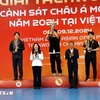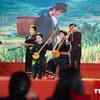UNESCO’s World Heritage Committee recognises Vietnam’s Thang Long Royal Citadel as a world cultural heritage at its 34th session in Brazil on July 31, according to the Hanoi People’s Committee.
The site won the recognition thanks to its three outstanding characteristics: the length of its cultural history, the continuity of the citadel as a power centre, and the variety of relics it contains.
Relics found in the centre of the citadel show that it was influenced by many different cultures, theories, and systems of thought.
The centre of the citadel embodies the enduring cultural tradition of the people of Vietnam ’s Red River Delta, a tradition which has existed for 13 centuries.
Restoration of the Royal Citadel began in 2006 when it was officially recognised as a special national relic.
The Hanoi People’s Committee said UNESCO’s recognition of the heritage is very significant for Vietnam , which is currently making grand preparations for its capital’s millennial anniversary./.
The site won the recognition thanks to its three outstanding characteristics: the length of its cultural history, the continuity of the citadel as a power centre, and the variety of relics it contains.
Relics found in the centre of the citadel show that it was influenced by many different cultures, theories, and systems of thought.
The centre of the citadel embodies the enduring cultural tradition of the people of Vietnam ’s Red River Delta, a tradition which has existed for 13 centuries.
Restoration of the Royal Citadel began in 2006 when it was officially recognised as a special national relic.
The Hanoi People’s Committee said UNESCO’s recognition of the heritage is very significant for Vietnam , which is currently making grand preparations for its capital’s millennial anniversary./.



















